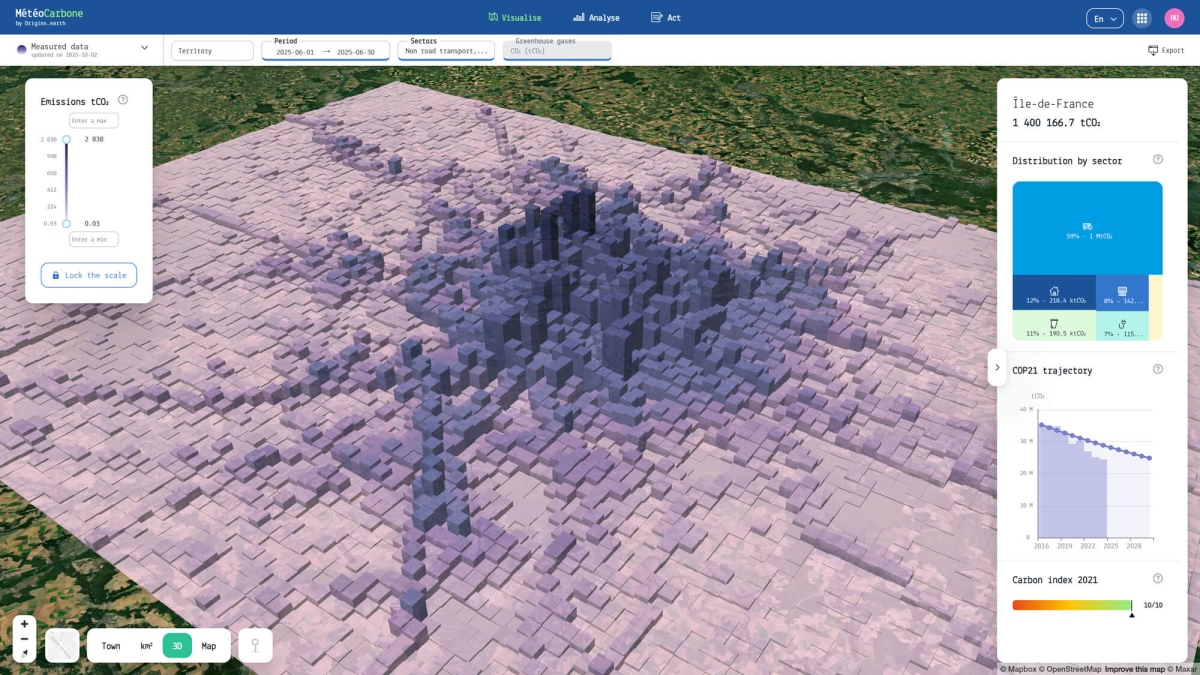
How do cities know if their climate actions are working? Innovative tools and data services are emerging to answer this critical question. These solutions, from open data initiatives to online platforms, are providing cities with the information required to measure progress, optimise strategies, and achieve their environmental goals.
Key takeaways
- Data is key for effective policy. Cities need reliable, granular data to identify where emissions are coming from, enabling them to prioritise actions that will have the greatest impact.
- A new generation of tools is emerging. Innovative platforms and services are helping cities measure, visualise, and even predict emissions in real-time.
- Understanding and using data is a challenge. While many tools are available, cities – especially smaller ones – often lack the expertise and resources to effectively use the data
Open-access data platforms like ICOS Cities, combined with analytical services and tools, can help policymakers see where emissions are being reduced and which policies could deliver the greatest climate benefits.
“Data is important to assess the magnitude of different emission sectors – and then to identify where emissions reductions will be most effective,” says Dr Andreas Christen, Professor of Environmental Meteorology at the University of Freiburg.
Cities want to know exactly where their emissions come from in order to understand which sectors to address, explains Dr Christen, who works on the ICOS Cities project, exploring which methodologies can be used to quantify city emissions on different scales and ensuring data is useful.
“Let’s say your city does a large-scale tree planting initiative – is that actually helping to absorb some of the emissions or is that not relevant? If the city implements traffic changes, will that actually have effects?” says Professor Christen.
Contextualising data for cities
ICOS Cities is also working on prototypes to help contextualise this data for cities on different scales and across various sectors, as well as developing ways of bringing cities together to discuss this this.
Private services are also exploring this. For instance, Origins.earth, a consortium partner in ICOS Cities, is converting open-source emissions data into a tool that cities can use to track their real-time emissions, divided by sector.
“The tool we have developed aims to address three needs of communities: visualise, evaluate, and predict,” explains David Duccini, Chief Executive Officer at Origins.earth. “Automatically, every day, we compute the inventory of the region. Automatically, we run the atmospheric model. Automatically, we integrate data from high-precision stations into the model and ensure that the input data are consistent with the physical observations.” he adds.
For the past six years, the company has measured the daily human-induced emissions of the greater Paris area and its 11.9 million inhabitants in real-time.
Alongside providing this data, Origins.earth’s tool provides scenarios to evaluate the effectiveness of green policies, which can help define targets for climate action plans. This tool is useful for two reasons: to help communicate with citizens about the measures creating changes in their cities and to evaluate public policy, says Duccini.
“Actions to reduce emissions often require citizens to make major changes in their lifestyle and habits. Think, for example, of changes in public mobility or low-emission zones. Graphically visualising the impact of their efforts and making the results tangible, even to non-climate specialists, strongly contributes to citizen engagement,” he explains.
Administrations must also integrate metric indicators into their decarbonisation plans to assess the impact of policies and determine what is required in the future to reach the city’s goals, says Duccini. This is something Origins.earth aims to show with its forecast function.
A range of tools available
Other tools are also available to help cities. This includes Kausal, which provides monitoring and collaboration services as well as scenario-building tools, and ClimateView, which helps with monitoring and developing action plans.
Meanwhile, the Net Zero Planner tool, designed as part of the Climate-Neutral and Smart Cities mission, is freely available to all cities and helps assess the cost of policies versus the benefits. Google’s Environmental Insights Explorer (EIE) can also provide insights into transport and building emissions, rooftop solar potential, and tree canopy cover.
“While data quality varies by region, Google’s EIE and Climate TRACE1 serve as a useful starting point for cities developing their emissions inventory data collection methods. The tools are free, easy to use, and provide data cities may not currently have,” says Yasmina Grieco, Expert in Green and Digital Transformation at ICLEI Europe – Local Governments for Sustainability. She recently co-authored a study2 using Google’s dataset to analyse how urban transport infrastructure affects walking and cycling rates in over 11,000 cities.
“What’s particularly valuable is seeing the huge variety in solutions – some are expensive, some are cheap, some require major urban redesign, others work with existing infrastructure. This kind of comparative analysis is exactly what we need in climate policy because it shows us context specific solutions,” Grieco explains.
Challenges in collecting data
Distinguishing where carbon emissions come from is complex but essential to show cities where reductions are needed. CO2 is emitted from many different sources in urban areas, including transport, industry, and buildings.
The ICOS Cities project team is exploring how to disentangle these emissions, including differenting between naturally occurring carbon emissions and those from burning fossil fuels. The team is also looking at ways to identify carbon dioxide emissions from
particular sectors by tracking other pollutants, like carbon monoxide or nitrous oxides.
“For example, in addition to the emission of carbon dioxide during combustion, there is also an emission of the pollutant carbon monoxide. This is not found in CO2 emissions from breathing or when microbes decompose soils, so we can use this to help attribute CO2 to sources,” says Professor Christen.
Time and geographical indicators can also help build a picture of emissions from different sectors. For instance, the change in emission levels during rush hours and no-car days can reveal the scale of emissions from road transport.
Understanding data is crucial
Collaboration between different stakeholders and departments is key, particularly when setting targets, says Grieco. For example, the boundary of a city may be defined differently in different data sources, risking inconsistent reporting.
“The real challenge isn’t just getting the data – it’s making sure people understand and can act on it. For example, the transport department might share data, but if the sustainability team can’t interpret what they mean, you’re stuck,” she explains.
The real challenge isn’t just getting the data – it’s making sure people understand and can act on it.
Yasmina Grieco, Expert in Green and Digital Transformation at ICLEI Europe – Local Governments for Sustainability.
“You need sectoral departments to sign off on carbon reduction targets and show how they’ll actually hit the numbers. Most climate plans fail here – there’s a disconnect between who analyses the data and who has to deliver results. The most successful cities get all relevant departments collaborating from the start, not just sharing data after decisions are made,” Grieco adds.
However, the sort of insights that companies like Origins.earth offer are not yet widely accessible for cities, partly due to the sheer cost of monitoring stations, says Duccini. These services also require political backing, all the relevant actors to work together, and financial and human resources.
Professor Christen also highlights the capacity challenges faced by cities, particularly smaller ones.
“It is clear that medium and small cities do not have the resources to monitor emissions on their own or even to use the data. There’s a shortage of staff and expertise in many cases,” he explains.
Despite these challenges, there is a clear benefit for cities to not only understand their emissions but also to see how these could be affected by future policy. According to Duccini, the recent Olympic Games hosted in Paris are a concrete case study of the benefits of Origins.earth’s tool.
“By studying the detailed impact in the individual geographical areas of the city, we were able to learn a lot about how to optimise the regulation of city traffic, for example,” he says.
What if observational data were freely available?
One outcome of the ICOS Cities project is the vision of a European network of greenhouse gas observations in cities. This network would continue integrated observations not only in Paris, Munich, and Zurich, but a number of additional cities.
“If we can continuously produce standardised and reliable data in – let’s say – 10 to 15 representative cities, companies like Origins.earth could use that data to calibrate their services and apply them in dozens of other cities,” says Dr Werner Kutsch, Director General of ICOS and Coordinator of the ICOS Cities project.
This ‘ICOS Cities Network’ would ideally provide the observational data and tools (mainly in the form of models) to improve the climate action services outlined above.
“We might call these cities calibration cities,” adds Kutsch.
These cities would boost scientific knowledge to improve inventories, better plan city’s action, and to verify their impact. If ICOS ran these observational network and scientific services, it would free cities from paying high costs for observations.
“The challenge is to convince the ICOS member countries to invest public money into the necessary infrastructure and its maintenance,” Kutsch says
Turning raw data into climate solutions
By Kira Taylor
Monitoring greenhouse gas emissions can help cities understand hotspots and the effectiveness of their policies, but this requires navigating vast, complex datasets. The ICOS Cities project is developing tools to make emissions data more understandable and useable.
Part of the ICOS Cities project has been to make data more useful to cities. ICOS Cities data is open access, so it’s available to everyone, but it’s quite abstract. It provides in-depth knowledge from a physics and atmospheric science point of view, but remains relatively detached from the on-the-ground challenges of city actors,” explains Dr Katie Berns, a researcher at Aalto University, working on the project.
Based on feedback from city authorities and policymakers, the team has designed three prototypes:
1. Policy dashboard for emissions data
The policy dashboard is designed to contextualise ICOS data in relation to other datasets already collected by cities, bringing together sector-based insights with geographic and demographic data, and enabling cities to look at emission hotspots, track emissions data over time, and explore future projections.
Because similar dashboards tend to be quite expensive, the idea is to have an open-source tool that allows smaller cities to only use the features they require, making it cheaper.
2. City-to-city collaboration
The team is also exploring matching cities of similar sizes and with similar challenges to enable them to learn from each other.
“We’d really like to create a space where cities can share ideas and initiatives that they’ve been working on: what works, what doesn’t work. I think a lot of cities are quite open to sharing their successes, but not necessarily their failures,” says Dr Berns, adding that it is important for cities to incorporate existing knowledge and learn from one another.
Cities in Europe are already collaborating through many initiatives, but the project team is hoping to add another dimension to this.
3. Citizen engagement infrastructure
This infrastructure aims to enable policymakers, city officials, and residents to work together to define climate challenges, refine project options, and explore impacts using ICOS and city data. It also enables them to review, implement, and share results.
A central element of this service is the ‘scenario selector’ tool that uses ICOS emissions projections to predict the impacts of potential projects and help cities weigh up the costs and benefits of different climate measures.
Dr Berns hopes that, in addition to being developed into services, these prototypes will also inform existing ones and show how data sets can be integrated.
“Cities are already using a lot of dashboards and tools. So it is important to consider how new services might fit into pre-existing digital ecosystems,” she explains.
City-to-city insights
By Charlotta Henry
Cities are keen on using data for improving climate action.
1. Is your city using data analytics or specific software tools to identify where climate action efforts would be most effective?
2. What kind of data analytics or software tool, if it existed, would be a ‘game-changer’ for your city’s climate planning?

1. We do not really have a specific tool but we mostly use greenhouse gas inventories and the Net Zero Planner, provided in the Cities Mission, in order to estimate 2030 decarbonisation pathways.
2. A game changing tool would be one that estimated the real impact of specific
greenhouse gas reduction actions, with temporal and spatial accuracy. The link between projects and greenhouse gas reduction is often complex and uncertain. This is particularly true for projects that depend on shifting citizen habits or that rely on indirect impacts.

1. The City of Zurich monitors the effectiveness of its climate protection measures based on the development of target indicators published online in the Net Zero Cockpit. Users can also interactively visualise scenarios that demonstrate the impact of measures on target achievement. This is a version of Causal Path adapted to the needs of the City of Zurich.
2. Near-real-time values and visualisations would help provide a timely overview of concentration trends (e.g., for continuous air pollutants) and potentially reveal the impact of measures. Additionally, AI-based analyses would help identify ‘patterns’ of potential measures. Future measures could also be anticipated based on concentration trends.

1. For the moment, we don’t have analytics or software tools in use for this purpose.
2. A real game-changer would be a tool that could provide a far more precise and transparent picture of both direct and indirect emissions. Current methods like traffic emission calculations still rely heavily on assumptions.
For example, a comprehensive construction project database that highlights main emission sources would greatly improve the evidence base for decision-making.
The most transformative, however, would be an integrated platform that combines a holistic view of the city’s emissions and adaptation needs with the costs of climate actions, allowing measures to be prioritised by cost-effectiveness.
References
1 Climate TRACE tracks emissions using satellites, other remote sensing techniques, and artificial intelligence to deliver a detailed look at global emissions.
2 A. Millard-Ball,M. Reginald,Y. Yusuf, & C. Bian, Global health and climate benefits from walking and cycling infrastructure, Proc. Natl. Acad. Sci. U.S.A. 122 (24) e2422334122, 2025
